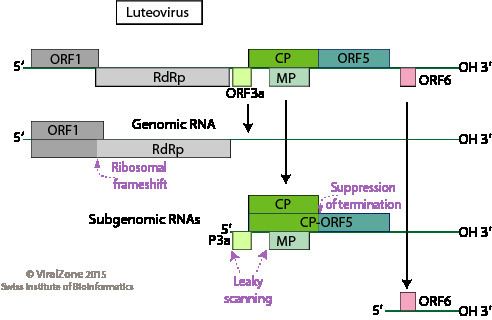Group Group IV ((+)ssRNA) Higher classification Luteoviridae | Family Luteoviridae Rank Genus | |
 | ||
Similar Barley yellow dwarf, Polerovirus, Beet western yellows vi, Potato leafroll virus, Pea enation mosaic vi | ||
Medical vocabulary what does luteovirus mean
Luteovirus is a genus of viruses, in the family Luteoviridae. There are currently eight species in this genus including the type species Barley yellow dwarf virus-PAV. Plants serve as natural hosts. The geographical distribution of Luteoviruses is widespread, with the virus primarily infecting plants via transmission by aphid vectors. The virus only replicates within the host cell and not within the vector [1]. The name 'luteovirus' arises from the Latin luteus, which is translated as 'yellow'. Luteovirus was given this name due to the symptomatic yellowing of the plant that occurs as a result of infection.
Contents
- Medical vocabulary what does luteovirus mean
- Taxonomy
- Morphology and genome structure
- Life Cycle
- References
Taxonomy
Group: ssRNA(+)
Morphology and genome structure
Viruses in Luteovirus are non-enveloped, with icosahedral and spherical geometries, and T=3 symmetry. The diameter is around 25-30 nm, with 32 capsomeres in each nucleocapsid. The nucleic acid content is around 28%. Luteovirus is a group IV virus according to the Baltimore classification of viruses. Each virion contains a single strand of (+) sense RNA. The genome is non-segmented, linear and between 5300 and 5900 nucleotides long. Notably, luteovirus has two 5' open reading frames (ORFs) which are located upstream of the coat protein. One such ORF encodes an RNA-dependent RNA polymerase. Several other ORFs are present at the 3' terminus and are expressed from subgenomic RNA. Luteovirus also lacks polyadenylation at the 3' terminus.
Life Cycle
Viral replication is cytoplasmic. Entry into the host cell is achieved by penetration into the host cell. Replication follows the positive stranded RNA virus replication model. Positive stranded RNA virus transcription is the method of transcription. Translation takes place by leaky scanning, -1 ribosomal frameshifting, and suppression of termination. The virus exits the host cell by tubule-guided viral movement. Plants serve as the natural host. The virus is transmitted via a vector (insects). Transmission routes are vector and mechanical.
